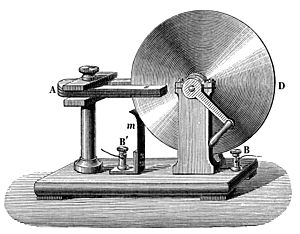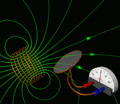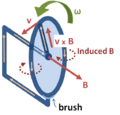Faraday's law of induction facts for kids
Faraday's law of induction is a basic rule in physics that helps us understand electricity and magnetism. It was discovered by the English physicist Michael Faraday in 1831. This law explains how generators, transformers, and electric motors work.
Simply put, Faraday's law says that if a magnetic field changes, it can create a voltage. This voltage is like a "push" that can make electric current flow in a wire. Another scientist, Joseph Henry, also found this out around the same time in 1831.
Imagine you have a loop of wire. To understand how much electricity can be made (or "induced") in this wire by a changing magnetic field, we need to think about something called the magnetic flux. Magnetic flux is a way to measure how much of the magnetic field is actually passing through the wire loop.
Think of the wire loop as the edge of a thin surface, like a soap bubble film. The magnetic flux tells us how many magnetic field lines are going through that "soap film." Magnetic fields have both a strength and a direction. So, we look at every tiny part of that surface and see how much the magnetic field is pointing straight through it. When we add up all these measurements, we get the total magnetic flux.
When this magnetic flux changes, it creates an electromotive force (often called EMF). This EMF is the voltage that can drive an electric current. The magnetic flux can change in a few ways:
- The strength of the magnetic field itself changes.
- The wire loop moves or changes its shape within the magnetic field.
- Both of these things happen at the same time.
The amount of EMF created also depends on how many loops of wire you have. If you have more loops (like in a coil), you get more EMF. The faster the magnetic flux changes, the stronger the EMF will be. There's also something called Lenz's law, which tells us the direction of the electric current that is created. It always flows in a way that tries to stop the change in the magnetic field that caused it.
History of Faraday's Law
Electromagnetic induction, which is the idea behind Faraday's law, was discovered by Michael Faraday in 1831. It was also found independently by Joseph Henry in 1832. However, Faraday was the first to share his findings with the world.
On August 29, 1831, Faraday wrote in his notebook about an important experiment. He wrapped two wires around opposite sides of an iron ring, similar to a modern toroidal transformer. He thought that when electricity started flowing in one wire, it might create a "wave" through the iron ring that would affect the other wire. He was right! When he connected or disconnected a battery to one wire, a device called a galvanometer (which measures small currents) showed a quick burst of electricity in the other wire. This happened because connecting or disconnecting the battery caused the magnetic field in the iron ring to change, which then created electricity in the second wire.
Within a couple of months, Faraday found other ways to show electromagnetic induction. For example, he saw brief currents when he quickly moved a bar magnet in and out of a coil of wires. He also created a steady electric current by spinning a copper disk near a bar magnet. This invention, known as "Faraday's disk," was the very first electric generator.

Faraday explained his discoveries using a concept he called "lines of force." At first, many scientists didn't accept his ideas because they weren't written down using mathematical equations. However, James Clerk Maxwell later used Faraday's ideas to create his famous mathematical theory of electromagnetism in the 1860s. Maxwell's work included a version of Faraday's law that is still used today as part of Maxwell's equations.
Lenz's law, which was developed by Emil Lenz in 1834, helps us understand the direction of the induced current and EMF. It explains that the induced current always flows in a way that opposes the change in magnetic flux that created it.
Images for kids
-
Faraday's experiment showing induction between coils of wire: The liquid battery (right) provides a current which flows through the small coil (A), creating a magnetic field. When the coils are stationary, no current is induced. But when the small coil is moved in or out of the large coil (B), the magnetic flux through the large coil changes, inducing a current which is detected by the galvanometer (G).
-
A Left Hand Rule for Faraday's Law. The sign of ΔΦB, the change in flux, is found based on the relationship between the magnetic field B, the area of the loop A, and the normal n to that area, as represented by the fingers of the left hand. If ΔΦB is positive, the direction of the emf is the same as that of the curved fingers (yellow arrowheads). If ΔΦB is negative, the direction of the emf is against the arrowheads.
-
Faraday's homopolar generator. The disc rotates with angular rate ω, sweeping the conducting radius circularly in the static magnetic field B (which direction is along the disk surface normal). The magnetic Lorentz force v × B drives a current along the conducting radius to the conducting rim, and from there the circuit completes through the lower brush and the axle supporting the disc. This device generates an emf and a current, although the shape of the "circuit" is constant and thus the flux through the circuit does not change with time.
-
A wire (solid red lines) connects to two touching metal plates (silver) to form a circuit. The whole system sits in a uniform magnetic field, normal to the page. If the abstract path ∂Σ follows the primary path of current flow (marked in red), then the magnetic flux through this path changes dramatically as the plates are rotated, yet the emf is almost zero. After Feynman Lectures on Physics
See also
 In Spanish: Ley de Faraday para niños
In Spanish: Ley de Faraday para niños







